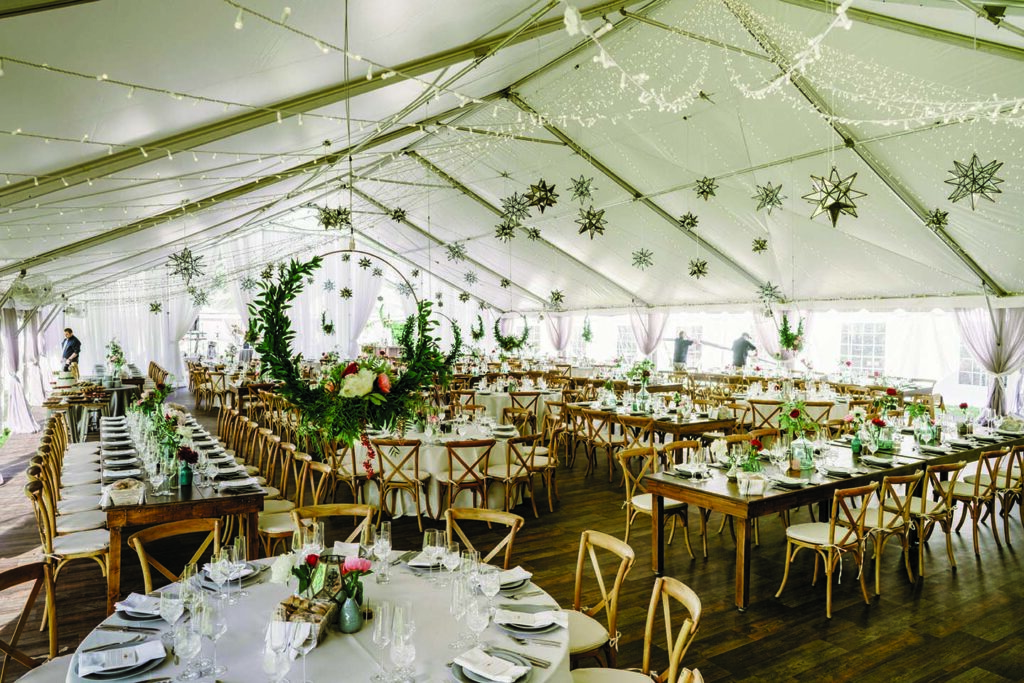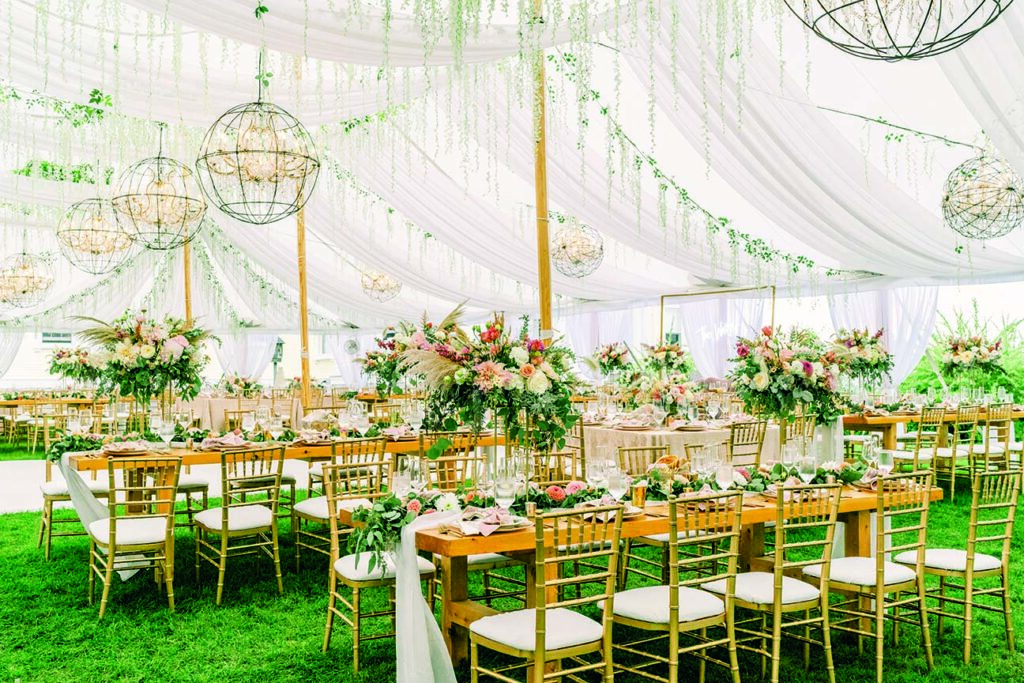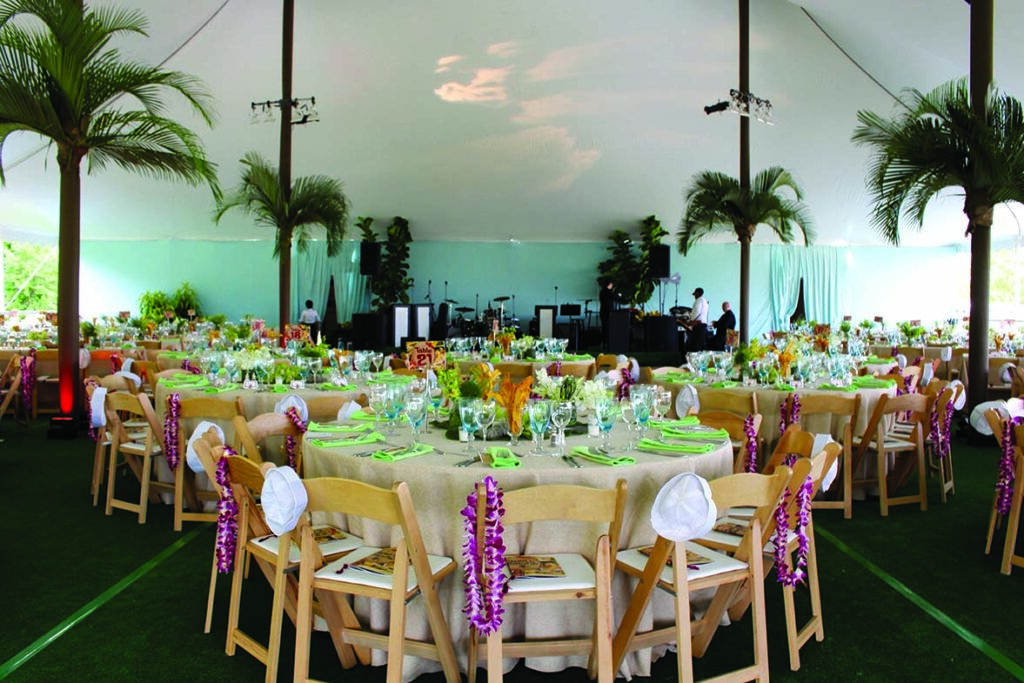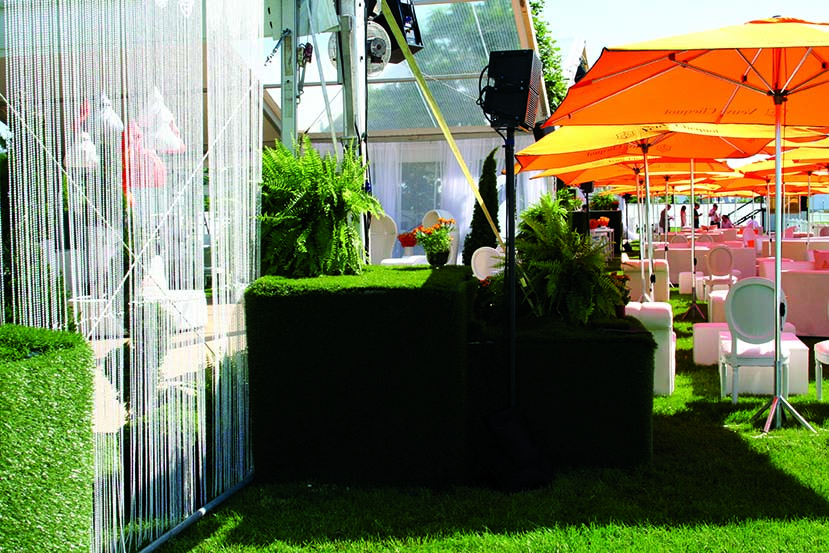The blank slate that is a tent offers event planners plenty of opportunities to create unforgettable environments and experiences for their wedding clients. But at the same time, these structures pose certain challenges. For one thing, depending on the tent, the equipment involved and the client’s vision, a fair amount of camouflaging might be required in order to deliver the desired outcome.
Certain tent styles offer a more elegant feel to start and may need little in terms of interior concealment. But the simple frame tent, for example, often requires much more camouflaging to create an inviting space, explains Brett Galley, owner and director of special events Hollywood POP Gallery. With offices in New York, N.Y., and Greenwich, Conn., the global, full-service event planning, design and destination company has designed and produced parties for numerous celebrity and high-end corporate clients.
Tents with crossbar ceilings can also present a decor challenge, she adds.
“[These] can be difficult to camouflage. Even when covering the bars with fabric sleeves, you have the ceiling to contend with,” Galley says. “Depending on the style of the event you are creating, you might need gobo lighting or to completely swag the ceiling to hide the mechanics.”

Jon Hall, regional executive with EventWorks Rentals, says the hardest element to camouflage is the center pole on pole-style tents. “It’s literally right in the middle of a tent,” he says, adding that disguising air-conditioner units can also prove trying. Headquartered in Charleston, S.C., with eight locations in five states, the company offers an array of rental items for weddings, sporting events, corporate galas, festivals and more.
For Jaclyn Watson, owner of Jaclyn Watson Weddings & Events, along with structural aspects such as poles and guy ropes, hiding lighting and electrical equipment can be tough, primarily because these items require multiple cords and cables. Located in Vermont, the company provides a customized, “premier planning experience” for weddings and events throughout New England.
“Another challenging thing to hide in tents for weddings are the catering and service areas,” she adds. “This is because these areas typically require a lot of space and may have large, bulky equipment that is difficult to conceal.”

Invisibility isn’t cheap
Several factors influence the amount and type of camouflaging that can take place. One of these is budgets. As Galley explains, swagging an entire tent ceiling, which requires a lot of material and know-how, can be costly. But there are other less-pricey options available. For example, poles can be made to seemingly vanish through the use of inexpensive white fabric sleeves. Or, transforming poles into columns of balloons can make them part of a fun and festive decor, she says, delivering a “great bang for your buck.”
Hall says because of the costs, swagging isn’t automatically included in any sort of package, making it easier for customers to add or remove items like liners, swag and so on as their budget dictates. Some of the more economical camouflaging strategies he mentions include using plastic sleeving to cover interior pipework, greenery pieces and leg drapes.
“Ceiling swag itself has different levels of affordability to it as well, as it can range from a simple voile swag pattern to a very extensive full ceiling covering,” Hall adds. “There are also some tent manufacturers who have vinyl prints they’ll factory place on the pipework to give a tent a certain look. These can vary from a faux wood finish to just a straight black vinyl cover. These would typically apply to a high-budget, custom event.”

Codes trump camo
Fire codes, regulations and safety concerns are also considerations, significantly influencing what can and cannot be camouflaged, says Watson.
“For example, fire exits and other emergency exits must be clearly marked and visible at all times,” she explains. “Similarly, fire sprinklers, fire alarms and other safety features must be clearly visible and unobstructed in order to function properly. Additionally, certain materials and substances may be prohibited from being stored or used in certain areas due to their potential fire risk.”
Galley emphasizes the importance of having certified fire-resistant brands of fabric as well as fire extinguishers. Pulling the proper permits beforehand can help things run more smoothly and safely, and will dictate what fabric type and style can be used, she adds.
Hall points out that special event laws/regulations can vary tremendously between local governments and can even be in conflict with intersecting geographic areas, such as a city imposing more restrictions than a county, in which case the city requirements would win out.
“Some locations are very loose with their special event rules or don’t even have any permitting requirements for special events, while there are others with very specific guidelines,” he continues. “We’ve run into some that have restrictions as specific as mandating minimum spacing distance between pipe and drape components with the sidewall on a tent.”

Distracting and diverting
Watson employs a variety of techniques to hide less-appealing elements. One is covering metal poles with white chiffon linens to take away their coldness. Another is dropping chandeliers from the ceiling.
“[This] adds elegance but also helps the ceiling fade into the background, making guests feel like they are dancing under the stars,” she says. “When using tents that have hard lines or metal poles, like a Century or a frame tent, it’s important to make the ceiling feel almost translucent or fade into the background.”
Hall likes tent liners, describing these as mid-priced options and the “easiest and most effective” technique when it comes to camouflaging.
“Their installation is straightforward and will cover the entire roof,” he explains. “Ceiling drapes/swag allow you to be more creative in coming up with a design or pattern to divert attention from the frame tents to the decor.”

He frequently gets requests to cloak air-conditioner units situated inside the tent. What makes this tricky is that those from different providers aren’t always uniform in size, which means that the facades an event company might have on hand for this purpose won’t always work and aren’t necessarily what the client wants. Airflow in and out of the unit is another concern since this can affect other decor aspects. Consequently, he says, these situations almost always require a custom install. However, hiding restroom facilities is often less taxing.
“Hedge walls are a great option here, as well as potted plants/trees,” Hall says. “Something about adding nature to the ‘nature calls’ aspect of an event. Hedge walls can also work to hide generators. But usually, we’ll try to position other tents in a way to obstruct as much of that view as possible.”
What Watson sometimes does to mask bathrooms is to install them against a tree line, adding in hedge walls or using pipe and draping as camouflage (“But not too much, so it’s still visible,” she cautions).
Galley says Hollywood POP has created some unique facades for bathrooms that have ranged in style from thematic “outhouses” to elegant “palaces” in order to hide them. The company has also used drapery tunnels and innovative signage. As for generators, its strategy is to position them as distant from the event as possible and to deploy quiet “whisper” generators whenever it can.

She recalls one of her most challenging cover-up tasks involving an antiquated sewage and waste system on a private estate, with the tent placed next to that area. The solution? Completely covering it, then creating a large white flagpole upon which a huge banner with the wedding couple’s initials was flown throughout the celebration.
Lighting can provide a big camouflage assist, serving to gussy up a tent while distracting guests from noticing other elements. For example, gobos can effectively hide a ceiling while adding beauty and interest, says Galley; cafe lighting wrapped around center poles or used to line piping on a frame tents can do the same, says Hall.
Deploying any type of lighting is a strategy she “highly recommends,” says Watson.
“Lighting easily creates a mood, based on what you choose,” she explains. “For instance, if you’re in a tent that has a plastic, harder feel in the ceiling, doing a twinkle light canopy adds romance and softness. I personally love when we do a combo of lighting designs like mixing twinkle lights with branch antler chandeliers. Or chandeliers mixed in with a rattan basket lantern, creating a fun and boho feel, but still staying elegant. Lighting, even if you only use a ton of candles, enhances every wedding.”
Pamela Mills–Senn is a freelance writer based in Seal Beach, Calif.
SIDEBAR: Concealed support
Of all the elements that go into a tented event, ballast and other forms of anchoring are among the most critical, and yet, these essentials are expected to remain as unobtrusive as possible. Depending on the tent, the surface and the ballasting/anchoring required, this can prove challenging, says Nicholas Deninno, founder and chief operating officer of B&R Innovations. The company is located in Bethpage, N.Y., and serves clients in the U.S., Canada and in some international locations. Its flagship product is the Block and Roll® Tent Ballast Solutions®.
Among the hardest to conceal are uneven amounts of stacked ballast, Deninno says.
“Let’s say you need 1,500 pounds of ballast and you’re using 300-to-500-pound blocks,” he explains. “If you were to place all three on the ground in a triangle or two on the ground and a single one on top, it would create a difficult disguise. Or, you would need to make a larger cover to ‘square’ off the ballast. Equal number of ballast in the same size offers an easier solution.”
Another challenge is ensuring access isn’t obstructed by using ballast too wide for the space between the tent’s legs, a problem ballast coverings could exacerbate if the wrong approach was taken.
The company offers simple vinyl covers for hiding ballast that can be used on individual blocks or to cover clusters of blocks, says Deninno. These can be made with printed designs, for example to look like wood or even brand or marketing logos.
“There are so many ways to disguise ballast and no end to the creativity,” says Deninno. “One of my favorites and easiest is to cover ballast in artificial turf or artificial box hedges. It gives the ballast a natural look and blends in easily.
“Another way is to create wood boxes or planters,” he continues. “Planters are great because you can actually leave an open area on the box to put in dirt and plants or simply just add plants in pots close together.”
One install Deninno remembers from the time he owned a tent company was an event that had multiple connected tents. In certain areas where the tents were joined together, the client didn’t want to see any ballasting.
“Our solution was to use heavy steel plates and place them below the temporary flooring that was to be used,” he recalls. “This completely camouflaged the ballast, as it was hidden below the floor.”
The post Now you see it, now you don’t appeared first on InTents.







Leave A Comment